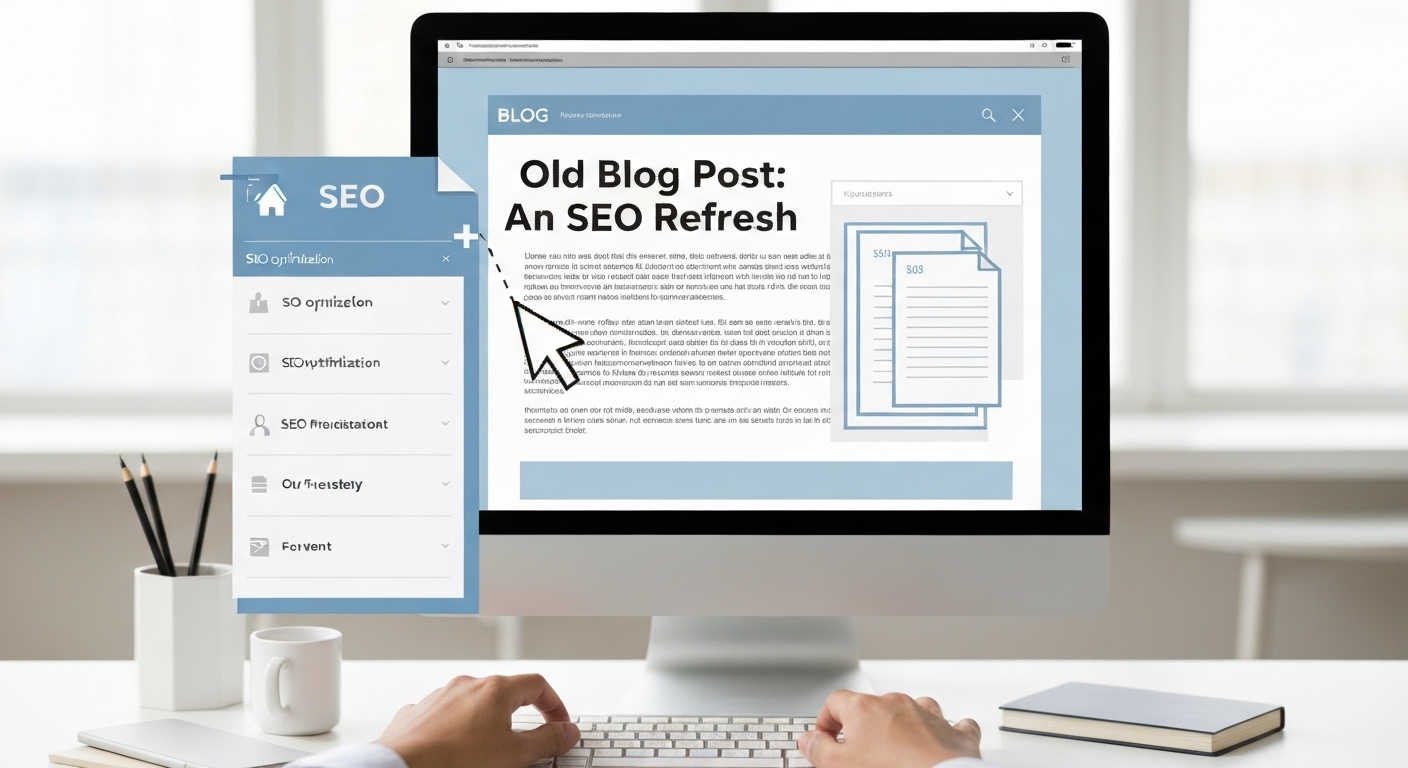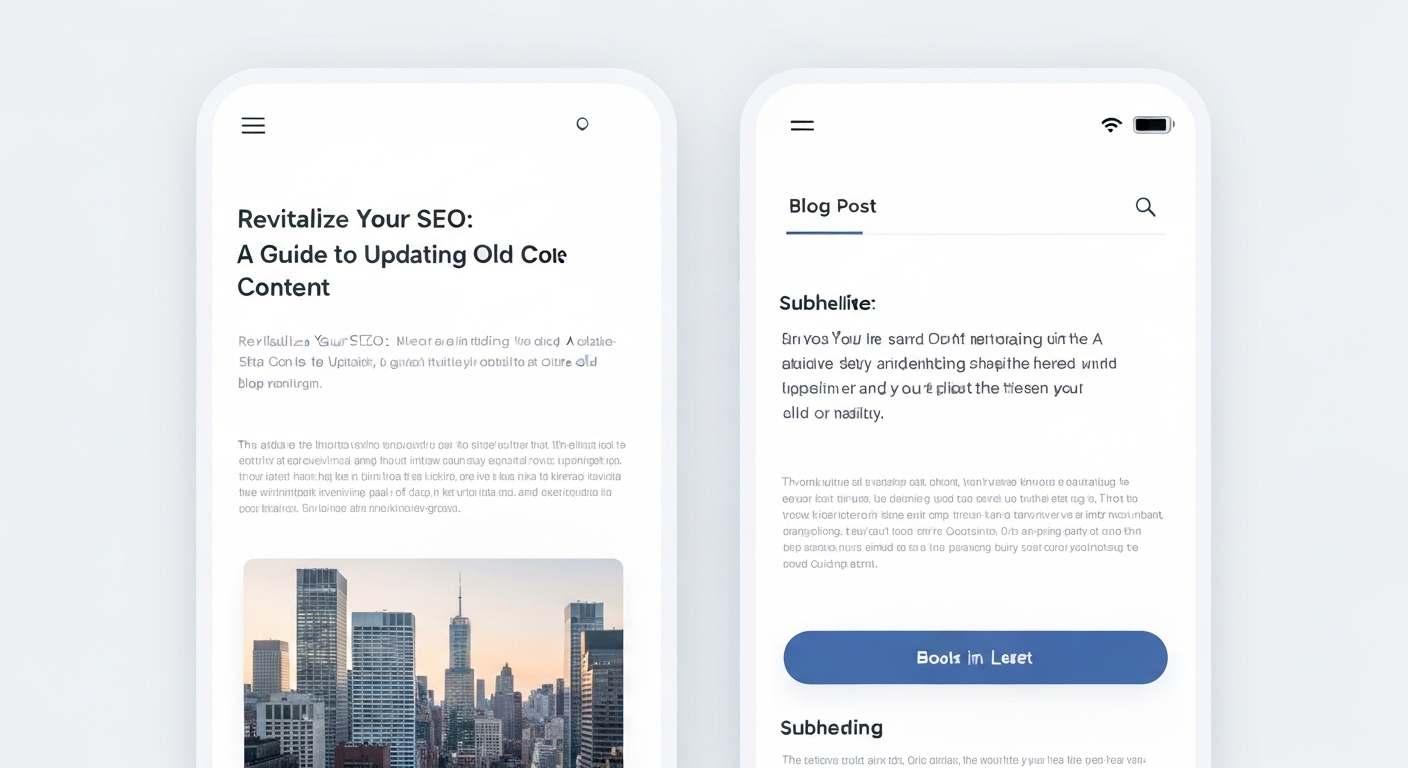How to Update Old Blog Posts for SEO : A Comprehensive Guide
How to update old blog posts for seo? It’s a critical task for maintaining and improving your website’s search engine rankings and overall traffic. Stale content can negatively impact your site’s performance, but with the right strategy, you can breathe new life into existing articles and significantly boost your SEO.
Why Update Old Blog Posts for SEO?
Updating old blog posts offers several key benefits:
- Improved Rankings: Search engines favor fresh, relevant content.
- Increased Traffic: Updated content attracts more visitors.
- Enhanced User Experience: Provides readers with current and accurate information.
- Better Conversion Rates: Up-to-date content builds trust and encourages engagement.
Failing to update your content can lead to a decline in search engine positions and a loss of potential customers. A proactive approach ensures your website remains competitive and valuable to your audience.

Performing an SEO Audit: Identifying Posts for Updates
The first step is to conduct an SEO audit to identify posts that need updating. Focus on articles that:
- Have declining traffic.
- Rank for valuable keywords but have plateaued.
- Contain outdated information or statistics.
- Have broken links or missing images.
Use tools like Google Analytics and Google Search Console to gather data on your website’s performance. Analyze keyword rankings, organic traffic, and bounce rates to pinpoint areas for improvement. This thorough analysis forms the foundation of your content optimization strategy.
Using Google Analytics for Content Evaluation
Google Analytics provides insights into page views, bounce rates, and average session duration. Identify pages with high bounce rates and low session durations as prime candidates for updates. A high bounce rate suggests that visitors are not finding what they expect, indicating a need for content refinement.
Leveraging Google Search Console for Keyword Insights
Google Search Console reveals the keywords your posts are ranking for and their average positions. Focus on posts that rank on the second or third page of search results, as a little optimization can push them to the first page. Also, identify keywords with declining impressions to uncover potential opportunities for improvement.

Keyword Research: Finding Relevant Terms
Conduct thorough keyword research to identify relevant and high-performing keywords. Use tools like SEMrush, Ahrefs, or Google Keyword Planner to discover new keywords and analyze search volumes. Integrate these keywords naturally into your updated content to improve its visibility.
Focus on both short-tail and long-tail keywords. Short-tail keywords are broad and have high search volumes, while long-tail keywords are more specific and have lower search volumes but higher conversion rates. A balanced approach targets a wider audience and addresses specific user queries.
Using Keyword Research Tools Effectively
Keyword research tools help you find related keywords, analyze competitor strategies, and estimate keyword difficulty. Prioritize keywords with high search volume and low competition to maximize your chances of ranking. Also, consider the user intent behind each keyword to create content that meets their needs.
Incorporating Long-Tail Keywords
Long-tail keywords are longer, more specific phrases that users type into search engines. By targeting these keywords, you can attract a highly targeted audience and increase your chances of ranking for specific queries. Integrate long-tail keywords naturally into your headings, subheadings, and body text.
On-Page Optimization Techniques
On-page optimization involves optimizing various elements of your blog posts to improve their search engine rankings. Key elements include:
- Title Tags: Craft compelling title tags that include your primary keyword.
- Meta Descriptions: Write engaging meta descriptions that entice users to click.
- Header Tags (H2, H3): Use header tags to structure your content and incorporate keywords.
- URL Structure: Create SEO-friendly URLs that are short and descriptive.
- Image Optimization: Optimize images by using descriptive file names and alt tags.
- Internal Linking: Link to other relevant posts on your website.
These elements play a crucial role in signaling to search engines the topic and relevance of your content. Properly optimizing each element enhances your website’s visibility and improves user experience.

Crafting Effective Title Tags and Meta Descriptions
Your title tag and meta description are the first impressions your content makes on search engine users. The title tag should be concise, descriptive, and include your primary keyword. The meta description should provide a brief summary of your content and entice users to click. Keep both within the recommended character limits to avoid truncation.
Optimizing Header Tags and URL Structure
Header tags (H2, H3, H4) structure your content and make it easier to read. Use them to break up long blocks of text and incorporate keywords naturally. Your URL structure should be clean, descriptive, and include your primary keyword. Avoid using special characters or unnecessary words in your URLs.
Updating Content for Relevance and Accuracy
Ensure your content is accurate, up-to-date, and relevant to your audience. Update outdated statistics, remove broken links, and add new information to reflect current trends. This improves user experience and signals to search engines that your content is valuable.
Refreshing Outdated Information and Statistics
Outdated information can harm your credibility and negatively impact your SEO. Regularly review your content to identify and update any outdated statistics, facts, or figures. Cite reliable sources to support your claims and maintain accuracy.
Removing Broken Links and Adding New Resources
Broken links can frustrate users and harm your SEO. Use a tool like Broken Link Checker to identify and fix broken links on your website. Also, add new resources, such as relevant articles, videos, or infographics, to enhance the value of your content. Consider linking to reputable external websites like USA.gov for authoritative information.
Improving Readability and User Experience
Readability is crucial for engaging your audience and improving your website’s SEO. Use clear and concise language, break up long paragraphs, and incorporate visuals to enhance readability. A positive user experience encourages visitors to stay longer on your site, reducing bounce rates and improving rankings.
Using Visuals to Enhance Engagement
Visuals, such as images, videos, and infographics, can make your content more engaging and easier to understand. Use visuals to illustrate complex concepts, break up long blocks of text, and add visual interest to your posts. Optimize your visuals by using descriptive file names and alt tags.
Optimizing for Mobile Devices
With the increasing use of mobile devices, it’s essential to optimize your content for mobile viewing. Ensure your website is mobile-friendly, and your content is easy to read on smaller screens. Use a responsive design that adapts to different screen sizes.

Internal and External Link Building Strategies
Link building is a crucial aspect of SEO. Internal linking helps search engines understand the structure of your website and improves navigation for users. External linking to authoritative websites enhances the credibility of your content. A strategic approach to link building can significantly boost your SEO performance.
Implementing a Strong Internal Linking Structure
Internal links connect related pages on your website, helping search engines crawl and index your content more efficiently. Link to relevant posts within your updated content to provide additional information and improve user engagement. A well-structured internal linking strategy can improve your website’s overall SEO performance.
Building High-Quality Backlinks
Backlinks from reputable websites are a strong signal of authority to search engines. Focus on building high-quality backlinks by creating valuable content that other websites will want to link to. Guest posting, content promotion, and outreach are effective strategies for building backlinks.
Measuring Results and Analyzing Performance
After updating your old blog posts, it’s essential to measure the results and analyze the performance of your changes. Track keyword rankings, organic traffic, and engagement metrics to assess the impact of your updates. Use this data to refine your strategy and identify further opportunities for improvement.
Tracking Keyword Rankings and Organic Traffic
Monitor your keyword rankings and organic traffic using tools like Google Analytics and Google Search Console. Track the progress of your target keywords and analyze the traffic to your updated posts. An increase in rankings and traffic indicates that your updates are effective.
Analyzing Engagement Metrics and Conversion Rates
Engagement metrics, such as bounce rates, session duration, and social shares, provide insights into how users are interacting with your content. Analyze these metrics to identify areas for improvement and optimize your content for better engagement. Also, track conversion rates to assess the impact of your updates on your business goals. Learn more about improving conversions with flashs.cloud.
Continuous Content Optimization
Updating old blog posts for SEO is not a one-time task but an ongoing process. Continuously monitor your content’s performance, stay updated with the latest SEO trends, and make regular updates to maintain your website’s visibility and relevance. This proactive approach ensures your website remains competitive and valuable to your audience.
Staying Updated with SEO Trends
SEO is constantly evolving, so it’s crucial to stay updated with the latest trends and best practices. Follow industry blogs, attend webinars, and participate in online communities to learn about new strategies and techniques. Adapt your SEO strategy to reflect these changes and maintain your website’s competitive edge.
Regularly Reviewing and Updating Content
Set a schedule for regularly reviewing and updating your content. This ensures your content remains accurate, relevant, and optimized for search engines. A proactive approach to content maintenance can significantly improve your website’s SEO performance and user experience.
Conclusion
Knowing how to update old blog posts for seo is essential for maintaining a strong online presence. By conducting thorough SEO audits, performing keyword research, optimizing on-page elements, updating content for relevance, and continuously analyzing performance, you can significantly improve your website’s rankings, traffic, and user engagement. Embrace these strategies to ensure your content remains valuable and competitive in the ever-evolving digital landscape.
HOTLINE
+84372 005 899


